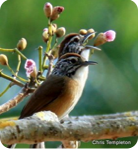Our research examines the evolutionary and ecological implications of animal behavior. Research projects are diverse, but often focus on how animals obtain and exchange information about their environments. The signals that animals use to communicate provide an incredible window into their cognitive abilities and ecological interactions, as well as insights into their evolutionary history. We study the behavior, cognition, learning, and ecology of animal communication, often focusing on birds.
This sonogram shows a duet from a pair of Happy Wrens, with each sex's contribution color coded.
Impact of noise on communication and cognition
Humans create an incredible amount of noise. How do these noises affect the way in which animals behave and communicate? We study how the acoustic properties of noise reduce information transfer within and between species through acoustically masking. We are also investigating how noise pollution affects the way animals learn to solve new challenges, both individually and socially from other birds, and ultimately how noise impacts animal populations.
Anti-predator communication
Many birds produce alarm calls to communicate about predators. What type of information is transmitted through these signals? Our work with black-capped chickadees (Poecile atricapillus) demonstrated a surprisingly sophisticated communication system in which alarm calls designate predator threat levels. We have continued studying alarm calls to better understand the evolution of information encoding strategies in different songbird species, how young birds learn to recognize and communicate about predators, and how eavesdropping creates vast information networks across communities of animals.
Vocal duetting
Pairs of neotropical wrens sing some of the most impressive coordinated duets and choruses of any animal, but how any why do they do it? We study the cognitive mechanisms that male and female birds use to coordinate their song phrases, how coordination and duet complexity have evolved across species, and how young birds learn to sing duets.


photo by Erick Greene
photo by Sue Anne Zollinger


